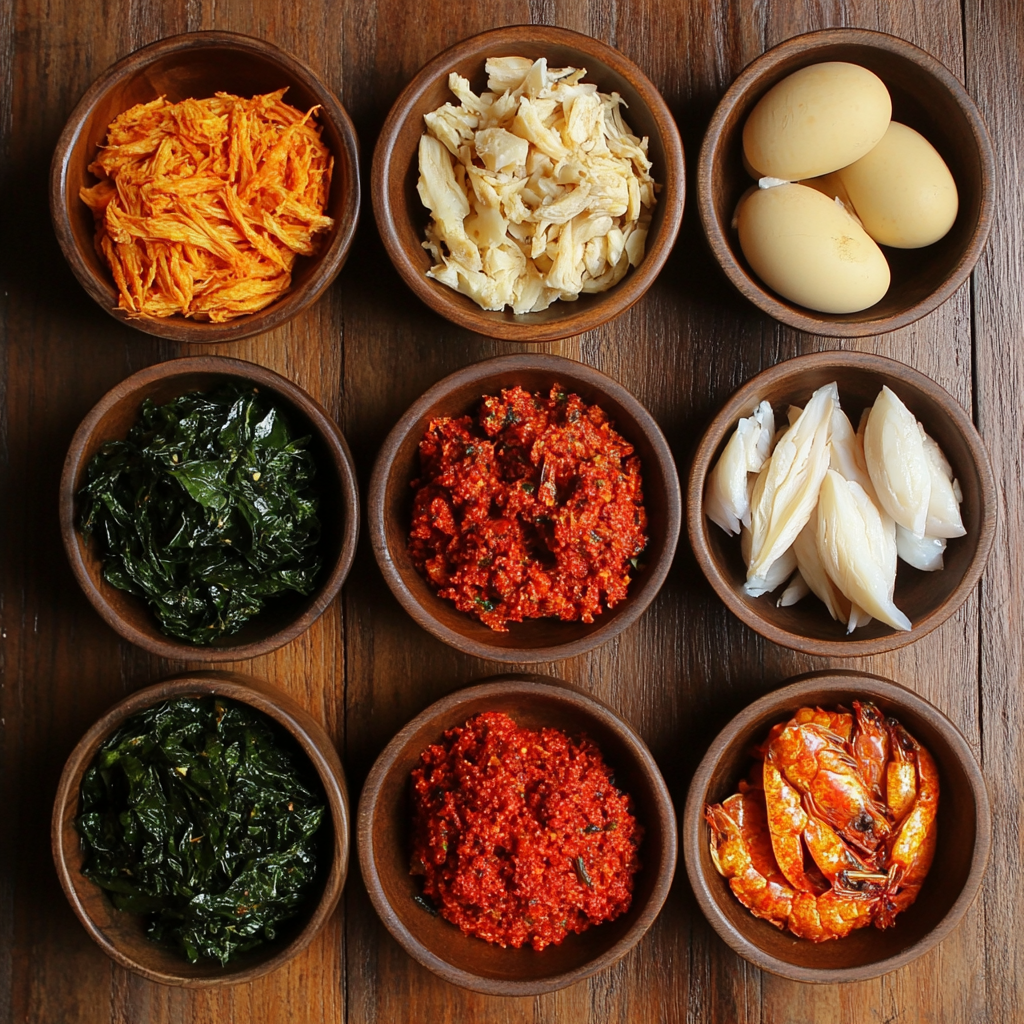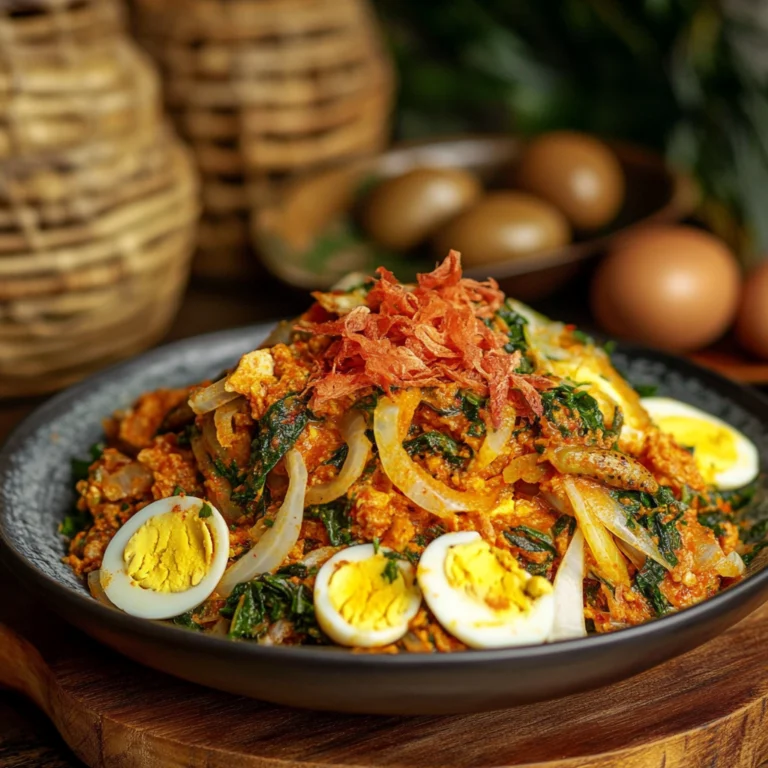Introduction to Abacha Salad
What is Abacha Salad?
Abacha salad, often called African salad, is a traditional Nigerian dish that features cut and dried cassava. This salad offers a vibrant mix of ingredients, highlighting the richness of Nigerian cooking. After softening the cassava, you use it as the base and mix it with palm oil, vegetables, Ugba (fermented oil bean), and various spices to create a tasty and fragrant dish.
The dish is especially valued in the southeastern region of Nigeria, where it started. Among the Igbo people, Abacha salad isn’t just food; it’s a cultural expression. Its bright colors and pleasing smell often make it the highlight of celebrations, events, and family gatherings. It shows the skill of Nigerian cooking while building a sense of community.
Table of contents
Historical Background
The history of Abacha salad closely ties to the Igbo tradition of Southeastern Nigeria. People introduced cassava to Africa from South America hundreds of years ago, and it quickly became a main crop due to its usefulness and resilience. The Igbo people, known for their creativity in cooking, developed methods to process cassava into various forms, including Abacha.
At first, the dish was a symbol of friendliness, often saved for important guests or special occasions. Over time, it became a much-loved meal, available in homes and sold by street vendors. Despite modern changes, its traditional preparation remains a source of pride for many Nigerians, making sure its legacy lives on.
Nutritional Overview
Abacha salad is not only tasty but also full of nutrients. Cassava, the main ingredient, is a rich source of energy-giving foods, helping with daily activities. Palm oil, a key part, is full of vitamins A and E, important for keeping healthy skin and vision.
The addition of Ugba adds protein and fiber, while plants like onions and cassava leaves give needed vitamins and minerals. Seasonings like dry fish paste and crayfish improve its flavor while contributing extra nutrients.
While cassava must be properly processed to remove natural toxins, Abacha salad in moderation offers a nutritious meal that balances energy with flavor. Combined with its cultural significance, it’s easy to see why this dish holds a special place in Nigerian cuisine.
Nutritional Content of Abacha Salad (Per 100g)
Below is an estimate of the nutritional composition of Abacha salad. Values may vary based on specific ingredients and preparation methods.
| Nutrient | Amount (Per 100g) |
|---|---|
| Calories | 150 kcal |
| Carbohydrates | 25 g |
| Protein | 4 g |
| Fat | 6 g |
| Fiber | 3 g |
| Vitamin A | 10% DV |
| Vitamin C | 8% DV |
| Iron | 6% DV |
| Calcium | 4% DV |
Core Ingredients of Abacha Salad
Cassava: The Primary Component
Cassava, a starchy root vegetable, is the main ingredient in Abacha salad. Native to South America, it found its way to Africa centuries ago and quickly became a common food due to its usefulness and flexibility. Known for its white, fleshy inside, cassava is full of energy-giving nutrients, making it a dependable source of energy.
To prepare Abacha, you carefully process the cassava root. First, peel and boil it to remove natural toxins. After cooking, slice it thinly or grate it into strands. Soak the strands in water to soften them, then dry them in the sun to create the unique texture of Abacha. This drying process extends its shelf life, making it a versatile ingredient for various dishes. When softened, the cassava transforms into a soft, chewy base that absorbs flavors well.
Ugba (Ukpaka): Fermented Oil Bean Seeds
Ugba, also called Ukpaka, is a traditional Nigerian ingredient made from processed oil bean seeds. Rich in protein and fiber, these seeds add a health boost to the dish. To prepare Ugba, boil and slice the seeds, then process them over a few days to develop their unique tangy flavor.
In Abacha salad, Ugba adds depth and layers to the taste. Its slightly sour, nutty notes balance the richness of palm oil and the heat of spices, creating a smooth blend of flavors. Additionally, it provides a pleasing texture, adding to the softness of softened cassava.
Palm Oil
Red palm oil, with its vibrant color and earthy flavor, is important in Abacha salad. Extracted from the fruit of the oil palm tree, this oil brings a rich, nutty aroma and a beautiful reddish hue that defines the dish.
Beyond its appearance and flavor contributions, palm oil is full of nutrients. It’s a natural source of vitamin A and protective compounds, which promote healthy vision and reduce stress from harmful elements. However, control is key, as it is high in calories. When used together with cassava and Ugba, it creates the perfect base for the salad’s bold flavors.
Potash (Akanwu or Kaun)
Potash, known locally as Akanwu or Kaun, plays a vital role in preparing Abacha salad. Typically, it is dissolved in water and then used to emulsify palm oil. As a result, the mixture transforms into a bright orange paste that evenly coats the cassava.
Though it’s an effective thickening and emulsifying agent, potash must be used sparingly. Consuming excessive amounts can pose health risks, so many cooks opt for alternatives like baking soda or lime juice. Regardless of the choice, this ingredient ensures the oil blends seamlessly, creating a smooth and flavorful mixture.
Crayfish
Ground crayfish is a small but mighty ingredient in Abacha salad. Made from dried and ground crustaceans, it delivers a savory, umami-packed punch that elevates the overall flavor.
Its rich, slightly briny taste pairs wonderfully with cassava, palm oil, and spices, adding depth to the dish. Just a sprinkle of crayfish can make all the difference, transforming a good Abacha into an unforgettable one.
Vegetables and Garnishes
Vegetables and garnishes breathe life into Abacha salad, offering a burst of color and texture. For example, common additions include thinly sliced onions, crunchy garden eggs, and tender garden egg leaves. Additionally, Utazi leaves are often included to provide a slightly bitter note, which helps balance the dish’s richness.
These ingredients not only enhance the salad’s visual appeal but also provide essential vitamins and minerals. Whether chopped, shredded, or layered, each element contributes to the dish’s vibrant character.
Proteins
Proteins such as stockfish, dry fish, ponmo (cow skin), and mackerel are frequently included in Abacha salad. These ingredients are typically cooked, deboned, and shredded before being mixed into the salad.
Each protein option offers its unique flavor profile: for instance, stockfish is savory, dry fish adds smokiness, ponmo provides a chewy texture, and mackerel brings a subtle, oily richness. When combined, these proteins elevate the salad from a simple side dish to a hearty and satisfying meal.
Seasonings and Spices
Seasonings and spices are the soul of Abacha salad, transforming simple ingredients into a flavorful masterpiece. Specifically, key spices include pepper for heat, calabash nutmeg (Ehuru) for its woody aroma, and Ogiri, a fermented condiment, for a pungent, umami depth.
Moreover, these seasonings are carefully balanced to ensure no single flavor overpowers the others. Instead, they blend seamlessly with the cassava, Ugba, and palm oil, resulting in a dish that is as aromatic as it is delicious.

Preparation of Abacha Salad
Preparing the Cassava (Abacha)
Transforming cassava into Abacha is a meticulous process that ensures the salad’s unique texture and flavor. Here’s how it’s done:
- Peeling: Begin by peeling the cassava to remove the tough outer layer. This step is crucial as the peel contains cyanogenic compounds that must be discarded.
- Boiling: Boil the peeled cassava until it’s tender but not mushy. This step helps soften the root and remove toxins.
- Grating: Once boiled, grate the cassava into thin, noodle-like strands. A grater or specialized tool is used to achieve uniformity.
- Soaking: Submerge the grated cassava in water for fermentation. This process, which lasts a few hours to a day, enhances the flavor and softens the texture.
- Drying: After fermentation, spread the strands under the sun to dry. Proper drying ensures the cassava can be stored for extended periods and rehydrated without becoming mushy.
Each step is essential. Peeling removes harmful substances, boiling and grating prepare the texture, soaking adds flavor, and drying ensures long-term usability.
Preparing Ugba (Ukpaka)
Ugba, or fermented oil bean seeds, adds a distinct tangy flavor to Abacha salad. Preparing it involves:
- Boiling the Seeds: Boil fresh oil bean seeds until they soften. This process may take several hours, depending on the seeds’ toughness.
- Slicing: Once boiled, slice the seeds into thin strips. Uniform slicing ensures even fermentation.
- Fermenting: Store the sliced seeds in a clean, covered container at room temperature for 2–3 days. This step develops their signature tangy taste.
For optimal results, maintain a clean environment during preparation to prevent contamination. Proper fermentation is key to unlocking Ugba’s nutty and tangy notes that perfectly complement the dish.
Assembling the Salad
Now comes the exciting part: bringing all the ingredients together to create Abacha salad. Follow these steps:
- Rehydrating the Abacha: Soak the dried cassava strands in lukewarm water for a few minutes. Drain and set aside.
- Emulsifying the Palm Oil: Dissolve a small amount of potash (Akanwu) in water. Add the mixture gradually to the palm oil, stirring until it forms a bright orange paste.
- Mixing: In a large bowl, combine the rehydrated cassava with the emulsified palm oil, ensuring every strand is evenly coated.
- Adding Ugba and Vegetables: Toss in Ugba, sliced onions, Utazi leaves, and any other vegetables. Mix gently to avoid breaking the cassava strands.
- Seasoning: Add ground crayfish, pepper, and a pinch of Ogiri. Adjust seasoning to taste, mixing thoroughly to distribute the flavors.
- Incorporating Proteins: Finally, add your choice of proteins like stockfish, ponmo, or mackerel. Ensure the proteins are evenly distributed throughout the salad.

Serving Suggestions
Presentation matters! To start, serve Abacha salad on a large, shallow plate to beautifully showcase its vibrant colors. Furthermore, garnish it with additional vegetables or protein to enhance its visual appeal.
To elevate the dining experience, pair the salad with refreshing non-alcoholic beverages or fruit juices. For an authentic touch, consider using traditional bowls or serving trays, which highlight its rich Nigerian heritage.
Variations and Regional Differences
Regional Variations
While Abacha salad originated among the Igbo people of Southeastern Nigeria, its preparation varies slightly across different regions, showcasing the culinary diversity of Nigeria.
In the Southeast, the dish sticks closely to tradition. Utazi leaves, known for their slightly bitter taste, are a staple garnish, while proteins like dry fish or stockfish are common. The use of potash to emulsify palm oil is a standard practice here, creating the iconic orange color.
Meanwhile, in some parts of the South-South, cooks often add smoked mackerel or shrimps for a coastal twist. Garden eggs, either raw or slightly roasted, are included more frequently, adding an extra layer of crunch and flavor.
In Northern Nigeria, where cassava is less prevalent, some variations replace cassava with yam flour or other local staples. Spices and seasonings may also differ, with milder heat levels to suit regional tastes.
These variations highlight how Abacha salad evolves while retaining its identity. The regional twists add depth to its appeal, ensuring that no two plates are ever quite the same.
Modern Adaptations
As global cuisines continue to influence traditional recipes, Abacha salad has evolved with modern adaptations to cater to contemporary palates. For instance, one popular twist involves adding avocado slices or diced tomatoes, which provide additional creaminess and freshness to the dish.
Health-conscious cooks often experiment with reducing the palm oil content, replacing it with healthier oils like coconut oil or skipping it altogether. Some even swap out cassava entirely, using spiralized zucchini or sweet potatoes for a low-carb version.
Fusion recipes have also gained traction, combining Abacha salad with Western ingredients. For instance, grilled chicken or beef skewers are served alongside the salad, or it’s used as a filling for wraps and sandwiches.
Cultural Significance of Abacha Salad
Role in Nigerian Celebrations
Abacha salad plays a central role in Nigerian celebrations, particularly in the Southeastern region. From weddings and naming ceremonies to festivals and community gatherings, this dish is often a highlight of the menu. Its vibrant colors and rich flavors make it a symbol of abundance and hospitality.
In Igbo culture, offering Abacha to guests demonstrates respect and warmth. Hosts often serve the dish in a happy atmosphere, bringing people together. During the New Yam Festival, for example, they include Abacha salad alongside other traditional dishes to celebrate the harvest season.
Beyond its culinary appeal, the dish carries special meaning. Specifically, its preparation and sharing reflect community values, emphasizing unity and closeness. As a result, this important cultural role ensures that Abacha salad remains a lasting part of Nigerian life.
Economic Importance
Abacha salad also holds financial value, particularly in the local sector. Street vendors and small food sellers often sell the dish in busy markets and local stalls, giving a source of income for many.
Additionally, it plays a role in food-based tourism. Nigerian cooking, with dishes like Abacha, brings in food lovers worldwide. Tourists eager to experience real flavors help the local economy by eating in traditional restaurants or joining cooking classes.
As a result, Abacha salad not only keeps alive cultural traditions but also boosts financial growth, proving its importance beyond the dining table.
Frequently Asked Questions (FAQs)
What is Abacha salad made of?
Abacha salad is made from cut and dried cassava, softened and mixed with palm oil, Ugba (processed oil bean), plants, and spices. Common additions include onions, garden egg leaves, Utazi, ground fish powder, and meats like stockfish or ponmo (cow skin). These parts combine to create a colorful and tasty dish that reflects the essence of Nigerian cooking.
Is Abacha salad healthy?
Yes, Abacha salad is a healthy dish when prepared properly. Cassava provides energy through its starch content, while palm oil offers vitamins A and E. The use of vegetables and Ugba adds fiber, protein, and important nutrients. However, eating in moderation is key, as cassava and palm oil are high in calories. Ensuring the cassava is well prepared also prevents potential health risks.
How is cassava processed for Abacha?
First, peel, boil, and grate the cassava into thin strands. Soak the strands in water to ferment and enhance their flavor. After fermenting the cassava, sun-dry it to preserve it. When ready to use, soak the dried strands in water to rehydrate them and create the base for Abacha salad.
Can I prepare Abacha salad without Ugba?
Yes, Abacha salad can be made without Ugba, although it adds a distinct flavor and texture. If unavailable, you can substitute Ugba with mushrooms or beans for a similar protein boost. While the dish may lack some of its traditional depth, it will still be delicious and satisfying.
What is Farro Salad Made Of?
Farro salad is a delightful and nutritious dish featuring farro, an ancient grain with a nutty taste and pleasantly chewy texture. Combine cooked farro with fresh ingredients such as cherry tomatoes, crisp cucumbers, or celery. Enhance the salad’s flavor and nutrition by adding protein-rich ingredients like chickpeas and creamy feta cheese. Brighten the dish with fresh herbs such as parsley, mint, or basil. Toss this mix with a tangy vinaigrette made from olive oil, lemon juice, or red wine vinegar to create a vibrant and satisfying dish.
Why Is It Called Israeli Salad?
Israeli salad earns its name from its strong connection to Israeli cuisine, where it serves as a beloved staple. This simple yet refreshing dish combines finely chopped tomatoes, cucumbers, and onions, lightly dressed with olive oil and lemon juice. Similar salads are common across the Middle East, but the version popular in Israel stands out as ‘Israeli salad’ due to its prominence in local kitchens and restaurants. The name highlights its widespread use in Israeli households and its role in the national culinary tradition, while also reflecting its shared roots with neighboring cultures.
Conclusion
Recap of Abacha Salad’s Significance
Abacha salad, with its vibrant colors, rich flavors, and cultural depth, is much more than just a meal—it’s a celebration of Nigerian heritage. Originating among the Igbo people, it has evolved to become a symbol of unity, hospitality, and tradition. From its carefully processed cassava base to its harmonious blend of proteins, vegetables, and spices, the dish exemplifies the creativity and resourcefulness of Nigerian cuisine.
Beyond its culinary appeal, Abacha salad holds a special place in Nigerian celebrations and contributes to local economies through street food vending and tourism. Its enduring popularity highlights the importance of preserving traditional recipes while embracing modern adaptations. Truly, it’s a dish that tells a story with every bite.
Encouragement to Explore Nigerian Cuisine
Now that you’ve discovered the essence of Abacha salad, why not try making it yourself? Preparing this dish at home is an opportunity to experience the flavors and traditions of Nigeria firsthand. While the process might seem intricate, the rewarding taste and cultural connection make it worth the effort.
Dive into this culinary adventure and explore the rich world of Nigerian cuisine. Whether you stick to tradition or add your own twist, Abacha salad is sure to impress your family and friends. It’s time to bring a taste of Nigeria to your table and celebrate the beauty of African food!

